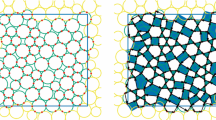Abstract:
We investigate both numerically and analytically the effect of strong disorder on the large-scale properties of the hyperbolic equations for stresses proposed in J.-P. Bouchaud, M.E. Cates, P. Claudin, J. Phys. I 5, 639 (1995), and J.P. Wittmer, P. Claudin, M.E. Cates, J.-P. Bouchaud, Nature 382, 336 (1996); J.P. Wittmer, P. Claudin, M.E. Cates, J. Phys. I 7, 39 (1997). The physical mechanism that we model is the local splitting of the force chains (the characteristics of the hyperbolic equation) by packing defects. In analogy with the theory of light diffusion in a turbid medium, we propose a Boltzmann-like equation to describe these processes. We show that, for isotropic packings, the resulting large-scale effective equations for the stresses have exactly the same structure as those of an elastic body, despite the fact that no displacement field needs to be introduced at all. Correspondingly, the response function evolves from a two-peak structure at short scales to a broad hump at large scales. We find, however, that the Poisson ratio is anomalously large and incompatible with classical elasticity theory that requires the reference state to be thermodynamically stable.
Similar content being viewed by others
Author information
Authors and Affiliations
Additional information
Received 13 November 2000 and Received in final form 3 January 2001
Rights and permissions
About this article
Cite this article
Bouchaud, JP., Claudin, P., Levine, D. et al. Force chain splitting in granular materials: A mechanism for large-scale pseudo-elastic behaviour. Eur. Phys. J. E 4, 451–457 (2001). https://doi.org/10.1007/s101890170100
Issue Date:
DOI: https://doi.org/10.1007/s101890170100




